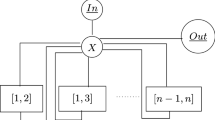Abstract
In this paper, we consider the computational power of a new variant of networks of splicing processors in which each processor as well as the data navigating throughout the network are now considered to be polarized. While the polarization of every processor is predefined (negative, neutral, positive), the polarization of data is dynamically computed by means of a valuation mapping. Consequently, the protocol of communication is naturally defined by means of this polarization. We show that networks of polarized splicing processors (NPSP) of size 2 are computationally complete, which immediately settles the question of designing computationally complete NPSPs of minimal size. With two more nodes we can simulate every nondeterministic Turing machine without increasing the time complexity. Particularly, we prove that NPSP of size 4 can accept all languages in NP in polynomial time. Furthermore, another computational model that is universal, namely the 2-tag system, can be simulated by NPSP of size 3 preserving the time complexity. All these results can be obtained with NPSPs with valuations in the set \(\{-1,0,1\}\) as well. We finally show that Turing machines can simulate a variant of NPSPs and discuss the time complexity of this simulation.
Similar content being viewed by others
References
Bottoni P, Labella A, Manea F, Mitrana V, Petre I, Sempere JM (2011) Complexity-preserving simulations among three variants of accepting networks of evolutionary processors. Nat Comput 10:429–445
Csuhaj-Varjú E, Mitrana V (2000) Evolutionary systems: a language generating device inspired by evolving communities of cells. Acta Inf 36:913–926
Csuhaj-Varjú E, Salomaa A (2005) Networks of parallel language processors. New Trends Form Lang LNCS 1218:299–318
Csuhaj-Varjú E, Kari L, Păun G (1996) Test tube distributed systems based on splicing. Comput Artif Intell 15:211–232
Drăgoi C, Manea F, Mitrana V (2007) Accepting networks of evolutionary processors with filtered connections. J Univers Comput Sci 13:1598–1614
Gómez-Canaval S, Ortega A, Orgaz P (2015a) Distributed simulation of NEPs based on-demand cloud elastic computation. Adv Comput Intell LNCS 9094:40–54
Gómez-Canaval S, Ordozgoiti B, Mozo A (2015b) NPEPE: massive natural computing engine for optimally solving NP-complete problems in big data scenarios. Commun Comput Inf Sci 539:207–217
Gray R, Kotz D, Nog S, Rus D, Cybenko G (1997) Mobile agents: the next generation in distributed computing. In: Proceedings of the 2nd AIZU international symposium on parallel algorithms/architecture synthesis, PAS’97. IEEE Computer Society, pp 8–24
Head T (1987) Formal language theory and DNA: an analysis of the generative capacity of specific recombinant behaviors. Bull Math Biol 49:737–759
Head T, Păun G, Pixton D (1996) Language theory and molecular genetics: generative mechanisms suggested by DNA recombination. Handb Form Lang 2:295–360
Hopcroft JE, Ullman JD (1979) Introduction to automata theory, languages and computation. Addison-Wesley, Reading
Loos R, Manea F, Mitrana V (2009) On small, reduced, and fast universal accepting networks of splicing processors. Theoret Comput Sci 410:406–416
Manea F, Martin-Vide C, Mitrana M (2006) All NP-problems can be solved in polynomial time by accepting networks of splicing processors of constant size. In: International workshop on DNA-based computers DNA12, LNCS, vol 4287, pp 47–57
Manea F, Martin-Vide C, Mitrana V (2007) Accepting networks of splicing processors: complexity results. Theoret Comput Sci 371:72–82
Margenstern M, Rogozhin Y (2001) Time-varying distributed H systems of degree 1 generate all recursively enumerable languages. In: Words, semigroups, and transductions. World Scientific Publishing, Singapore, pp 329–340
Margenstern M, Mitrana V, Perez-Jimenez M (2005) Accepting hybrid networks of evolutionary systems. In: DNA based computers 10 LNCS, vol 3384, pp 235–246
Martín-Vide C, Pazos J, Păun G, Rodríguez-Patón A (2002) A new class of symbolic abstract neural nets: tissue P systems. In: 8th annual international conference, COCOON 2002, LNCS, vol 2387, pp 290–299
Minsky ML (1962) Size and structure of universal turing machines using tag systems. In: Recursive function theory, symposium in pure mathematics, vol 5, pp 229–238
Morrison JP (2010) Flow-based programming: a new approach to application development, 2nd edn. J.P. Enterprises Ltd, Pune, p 2010
Papadimitriou CH (1994) Computational complexity. Addison-Wesley, Reading
Păun G (1996a) On the splicing operation. Discrete Appl Math 70:57–79
Păun G (1996b) Regular extended H systems are computationally universal. J Autom Lang Combin 1:27–36
Păun G (1997) DNA computing: distributed splicing systems. In: Structures in logic and computer science, LNCS, vol 1261, pp 351–370
Păun G (1998) Distributed architectures in DNA computing based on splicing: limiting the size of components. In: Unconventional models of computation. Springer, Berlin, pp 323–335
Păun A (1999) On time-varying H systems. Bull EATCS 67:157–164
Post EL (1943) Formal reductions of the general combinatorial decision problem. Am J Math 65:197–215
Rogozhin Y (1996) Small universal turing machines. Theoret Comput Sci 168:215–240
Woods D, Neary T (2009) The complexity of small universal turing machines: a survey. Theoret Comput Sci 410:443–450
Acknowledgements
A preliminary version of this work has been presented at TPNC 2017 and has been published in Theory and Practice of Natural Computing–6th International Conference, TPNC 2017, LNCS 10687, pp. 165–177. This work was supported by a grant of the Romanian National Authority for Scientific Research and Innovation, project number POC P-37-257. Victor Mitrana has also been supported by the Alexander von Humboldt Foundation.
Author information
Authors and Affiliations
Corresponding author
Rights and permissions
About this article
Cite this article
Bordihn, H., Mitrana, V., Negru, M.C. et al. Small networks of polarized splicing processors are universal. Nat Comput 17, 799–809 (2018). https://doi.org/10.1007/s11047-018-9691-0
Published:
Issue Date:
DOI: https://doi.org/10.1007/s11047-018-9691-0




